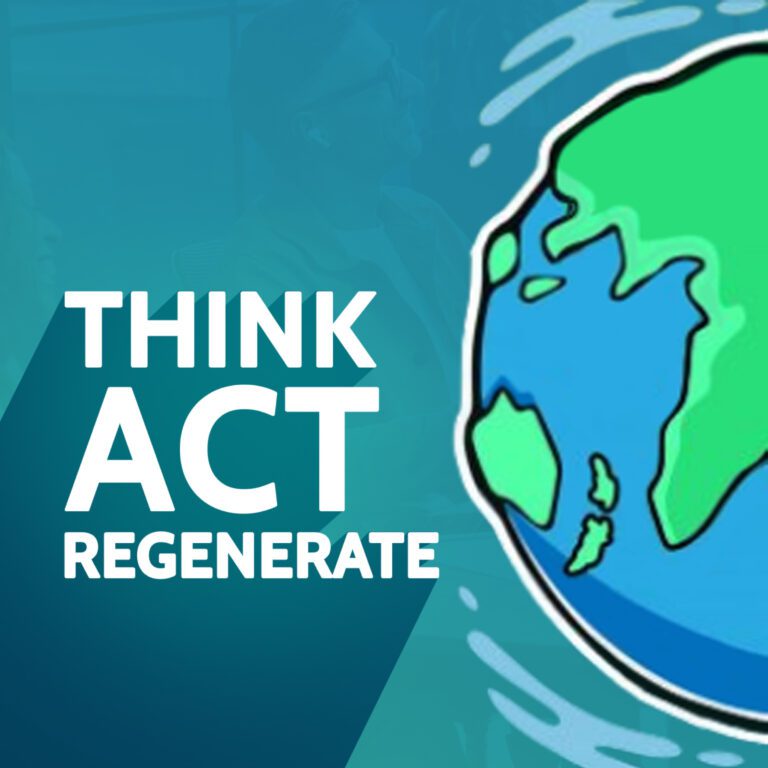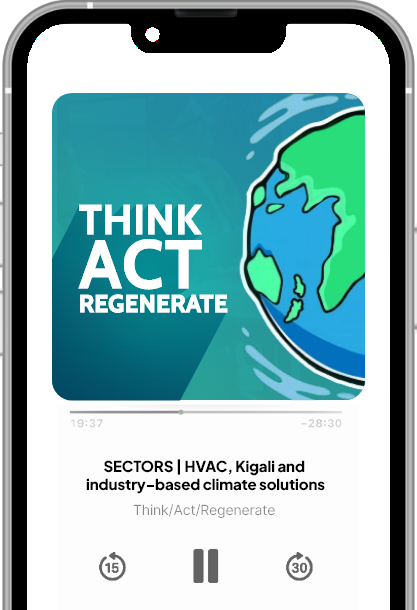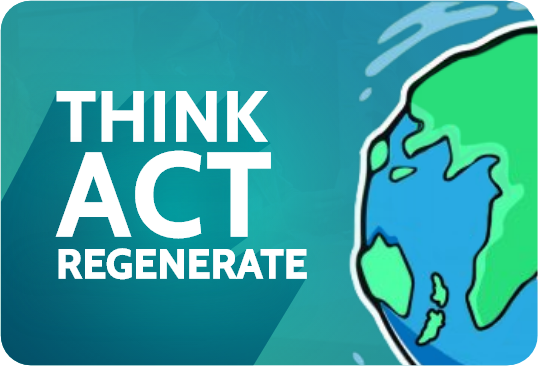
THINK ACT REGENERATE is a podcast by Leigh Baker of ThinkActRegenerate which explores the wealth of regenerative design solutions happening on the ground in Australia and New Zealand, as well as around the world.
The impact of industry-supported climate solutions is not well recognised. The US ratification of the Kigali Accord is one such example – which passed the US Senate with bipartisan support in late 2022. It was a solution supported by the HVAC-R industry and lobbied for by the industry – and is expected to reduce warming in 2100 by 0.35 to 0.5 degrees Centigrade.
The most powerful place you can take climate action may well be in your own industry. For example, the computer games industry has a powerful role to play – one outlined by Project Drawdown's A DRAWDOWN-ALIGNED FRAMEWORK FOR THE GAMING INDUSTRY.
The more you know about today's wealth of regenerative business solutions, the better your chances of being a powerful change agent.
LINKS
A Drawdown-Aligned Framework for the Gaming Industry: https://drawdown.org/publications/a-drawdown-aligned-framework-for-the-gaming-industry
”The US Senate ratifies international climate agreement in bipartisan vote” by Tim Treuer in The Waggle: https://mailchi.mp/regeneration.org/the-waggle-issue-27-hoflhgby6e?e=33eee9b47f
”The Senate ratified a climate change treaty with rare strong bipartisan support” NPR September 2022:
https://www.npr.org/2022/09/22/1124590392/the-senate-ratified-a-climate-change-treaty-with-rare-strong-bipartisan-support
Original music by Ian Hopkinson of hopkinsoncreative.com

(Recorded prior to Think Act Regenerate launch in 2024)
Today we’re talking about the power of industry action, using the HVAC-R industry (Heating, Ventilation, Airconditioning, Cooling, Refrigeration) as an example.
The impact of industry-supported climate solutions is not well recognised. The US ratification of the Kigali Accord is one such example – which passed the US Senate with bipartisan support in late 2022. It was a solution supported by the HVAC-R industry and lobbied for by the industry – and is expected to reduce warming in 2100 by 0.35 to 0.5 degrees Centigrade.
The most powerful place you can take climate action may well be in your own industry. For example, the computer games industry has a powerful role to play – one outlined by Project Drawdown’s A DRAWDOWN-ALIGNED FRAMEWORK FOR THE GAMING INDUSTRY.
Links
A Drawdown-Aligned Framework for the Gaming Industry:
https://drawdown.org/publications/a-drawdown-aligned-framework-for-the-gaming-industry
“The US Senate ratifies international climate agreement in bipartisan vote” by Tim Treuer in The Waggle:
https://mailchi.mp/regeneration.org/the-waggle-issue-27-hoflhgby6e?e=33eee9b47f
“The Senate ratified a climate change treaty with rare strong bipartisan support” NPR September 2022:
https://www.npr.org/2022/09/22/1124590392/the-senate-ratified-a-climate-change-treaty-with-rare-strong-bipartisan-support
Doughnut Economics Action Lab: https://doughnuteconomics.org/
Drawdown Job Function Action Guides: https://drawdown.org/programs/drawdown-labs/job-function-action-guides
Original music by Ian Hopkinson of Hopkinson Creative
Transcript
Hello, I’m Leigh Baker, your host for this episode of Regenomics Down Under. Today’s episode was recorded and produced on Wurrundjeri land on the outskirts of Melbourne in Australia.
Today we’re stepping back a bit to look at a key policy change in an industry that many people never see. HVAC heating, ventilation, air conditioning, and refrigeration.
There’s been a recent development that’s really going to make a difference to climate change that’s come out of the us. It happened in the US Senate on the 21st of September in 2022, and it’s in an area that you might have sort of thought was solved, which was the hole in the ozone layer.
The hole in the ozone layer is something that we identified back in the 1970s, and the experts at the time realized pretty quickly that it was being caused by chloroflurocarbons – the gases that are used in refrigeration and air conditioning. So having identified the problem early in the 1970s, by 1978 the Montreal protocol had been introduced.
To give it its full name, the Montreal Protocol on Substances that Deplete the Ozone Layer. And we started to get rid of the chloroflurocarbons, the CFCs that were the core problem. And today we know that the hole in the ozone layer is healing.
But there’s big but. Because when we replaced those chloroflurocarbons, we replaced them with hydro chloroflurocarbons, sometimes called hydrofluorocarbons.
And while those gases were okay for the ozone layer, the bad news is they turned out to be 1,000 to 9,000 times more powerful greenhouse gases than carbon dioxide. That’s a big oops. So it was back to the drawing board and back to the negotiating table.
In 2016, formal negotiations on the Kigali Amendment to the Montreal protocol began. (Kigali is the city where that agreement started to be negotiated.)
Negotiations have been continuing since 2016 in countries and industries around the world. One of the things that’s been happening is that the industry itself has been developing clean refrigerants.
Europe collectively signed off on the Kigali agreement in 2018. It took a bit longer in the US, but on September the 21st, 2022 in the US Senate something happened that many people in the climate world missed, particularly those who are focused on fossil fuel, cars and electricity.
After more than 10 years of debate and discussion, the US Senate ratified a binding international agreement – note that word binding – on greenhouse gases the Kigali agreement. More amazingly, the vote didn’t split along party lines. It was a bipartisan vote passed 69 to 27.
*****
So how big is this? In 2017 when Independent Climate Solutions researchers Project Draw down finished their first round of climate solutions modeling, they were really excited, but they were also a bit challenged by the results.
They’d spent three years building a super sophisticated model and assembling the massive libraries of independent peer reviewed data they needed to answer one question.
Can we actually solve global warming just using the commercial solutions we already have? They pushed the execute button on the model and they waited.
The good news was that the overall answer is yes, accelerating the solutions that we already have can have a massive positive result on limiting global warming.
However, the details behind the result were not quite what they were expecting. Solutions they had never expected to rank highly were in the top 10, and the number one solution was something particularly unexpected. It was better refrigerant gas management!
Wind turbines at number two they expected . Tropical forest restoration at number five wasn’t surprising, nor Solar Farms at number seven, or rooftop Solar at number 10.
Reduced food waste at number three was a big surprise. And refrigerant gas management at number one, that was seriously unexpected. And how the heck were they going to get people excited about that solution?
Since 2017, better Refrigerant Gas Management has stayed in the Drawdown top 10 with the 2022 draw down review of 93 solutions putting it at number nine,
The Kigali agreement that the US is now committed to phases down hydrochloroflurocarbons. That means that the super powerful greenhouse gases in most of today’s refrigerators and air conditioners, whether they’re supermarket display cases or your car air conditioner, are on their way out.
So why is Kigali exciting?
Firstly, it’s a firm international agreement. Unlike COP – the conference of the parties on climate – the Kigali agreement is mandatory. It has specific targets and timetables for actions and trade sanctions to punish failure to comply. It even has commitments by rich countries to help finance the cost of transition in the developing world.
And as one climate solution expert from Project Regeneration wrote in the Waggle newsletter on the 29th of September, that single binding amendment will reduce warming in 2100 by 0.35 to 0.5 degrees centigrade. Which is in the same ballpark as any round of new non-binding commitments made under the Paris Climate Accord.
It’s worth understanding why it got that amazing level of nonpartisan support from the US Senate. Speaking on NPR Energy and Climate Reporter Laura Benoff said. There’s one big factor. It wasn’t just climate friendly, it was business friendly.
Manufacturers, the Chamber of Commerce, they all lobbied for this to happen because these industries have already spent billions of dollars developing the next generation of refrigeration technology, and they want to be able to sell it where it will be in most demand.
*****
There is a whole smorgasbord of powerful systems level changes going on behind the scenes that are also important.
Transport and electricity generation are less than 50% of climate solutions. . There are many multi-benefit climate solutions that anyone can be in action with today. In an office or a plant room, or in agriculture or in construction. There’s an opportunity to make a difference and even to improve your career.
The Kigali agreement is an important step forward. It will make a real difference. And it was supported by industry and by the politicians lobbied by that industry.
Every industry has a role to play from car manufacturing to the computer games industry, and it’s not just a compliance role. Today’s solutions are about innovation and opportunity, not just using less. Any tech services company could probably add, adapt, Project Drawdowns 2023 Drawdown Aligned Framework for the Gaming Industry to their business.
The best place for you to take climate action could potentially be the industry you are already a part of, whether you take on a circular economy challenge, one of project Drawdown’s Job Function Action Guides, or a Doughnut Economics exploration.
There’s a wealth of climate solutions that you can be part of today, and they make the world better. The 93 Commercial Climate Solutions catalogued by Project Drawdown also deliver on 15 of the 17 United Nations Sustainable Development Goals.
The 74 action lists compiled by Project Regenerations experts cover everything from ocean regeneration to greening cities
The best of the climate solutions that we have today make the world better today.
A lot of them can be action today by communities, by individuals, by regional organizations, by SMEs. And the more you know about the solutions, the more effectively you can act.
AND vote for climate and lobby for climate. Remember it’s lobby AND take action. It’s protest AND act where you live on what you love.
Thanks for listening to this episode of THINK ACT REGENERATE. I’m Leigh Baker and I’ve been your host today. If you are interested in regenerative solutions on the ground in Australia and around the world, then follow the podcast on your favourite platform.












